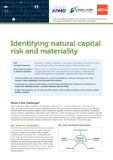This paper shows that:
- the definition of materiality is evolving to incorporate new issues, inclusive of more stakeholders, over greater time horizons
- many regulators, standard setters and sustainability reporting bodies are developing their frameworks to incorporate new forms of the materiality principle
- the issues and risks related to natural capital more likely to be included as material business concerns.
Natural capital – the stock of capital derived from natural resources such as biodiversity, ecosystems and services they provide – is declining globally. Business operations that have negative environmental impacts can have high, but often unrecognised costs for organisations, investors and society. Recent analysis estimates that global primary production and processing sectors (forestry, fisheries, agriculture, mining, oil and gas exploration, utilities, cement, steel, pulp and paper and petrochemicals) have unaccounted costs of US$7.3 trillion per year – mostly from greenhouse gas emissions, water use and land use.
The paper outlines how changing definitions of materiality affect the boundaries of materiality assessments, enhancing interest in and justification for natural capital’s consideration in corporate materiality assessments in relation to the three key areas:
- the scope of issues that are material broadening to the environmental and social impacts of organisations, including those related to natural capital
- the stakeholder groups to be included when assessing if an issue is material, extending to bodies such as NGOs and local communities that are concerned about natural capital issues.
- the time frame over which business impacts are considered material, incorporating previously unaccounted medium- and long-term impacts and effects on natural capital issues.
Incorporating natural capital issues in corporate materiality and risk assessments offers a range of benefits and value to companies: from better-informed decision making by an organisation and its stakeholders, to an enhanced and more comprehensive risk management process, to an increased ability to realise strategic opportunities.

